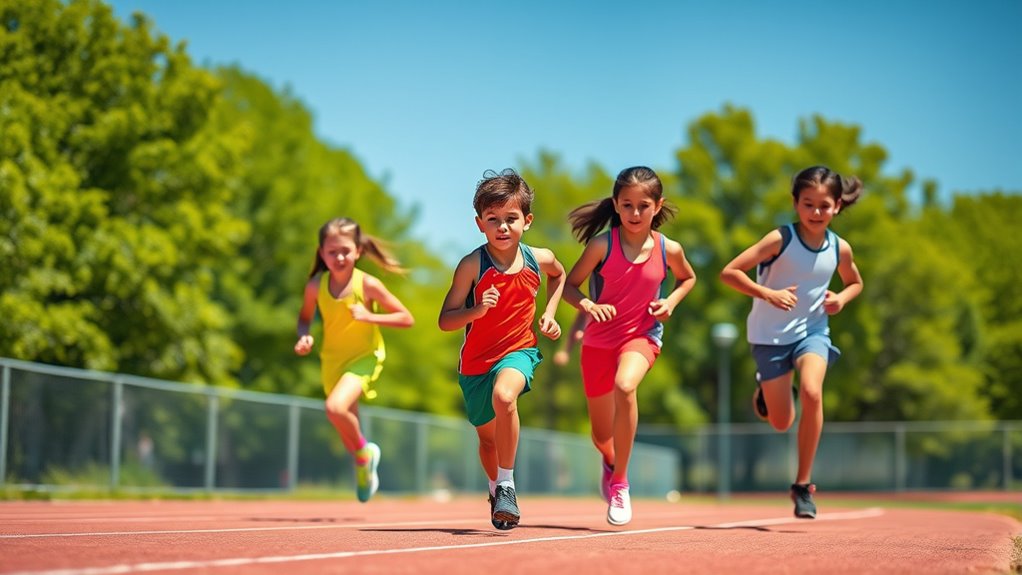To support youth running development, focus on gradual training increases, proper warm-up and cool-down routines, and teaching good running form. Encourage listening to pain signals and selecting supportive footwear to prevent injuries. Promote balanced activities, good nutrition, hydration, and sufficient sleep to boost recovery and performance. Creating a positive, fun environment helps build confidence and lifelong enjoyment of running. Keep exploring these guidelines to make certain a healthy, safe, and rewarding experience for young runners.
Key Takeaways
- Implement gradual increases in intensity and distance to support healthy growth and prevent overuse injuries.
- Teach proper running form, including upright posture and soft midfoot landings, to enhance safety and efficiency.
- Promote balanced training with cross-training activities and ensure adequate rest, hydration, and nutrition.
- Use appropriate footwear and monitor for signs of discomfort or fatigue to avoid injuries.
- Foster a positive, fun environment that encourages consistent participation and builds confidence in young runners.

As children grow and develop, establishing appropriate running guidelines is essential to nurture their athletic potential safely. When it comes to youth running, focusing on proper training techniques sets the foundation for healthy progress and helps prevent injuries. You should emphasize gradual increases in intensity and distance, allowing their bodies to adapt without undue stress. Avoid pushing kids too hard too soon; instead, encourage steady, manageable improvements that build confidence and strength over time. Proper warm-up routines are crucial, as they prepare muscles and joints for activity, reducing the risk of strains or sprains. Incorporate dynamic stretches and light jogging to get the body ready, and emphasize the importance of cooling down afterward to aid recovery.
Gradually increase running intensity and always prioritize warm-ups and cool-downs to keep children safe and injury-free.
In addition to training techniques, injury prevention is a key component of youth running guidelines. You need to educate children on listening to their bodies—if they feel pain or excessive fatigue, they should rest and seek guidance rather than pushing through discomfort. Proper footwear is vital; shoes should fit well, provide adequate support, and be appropriate for the child’s foot type. Wearing the wrong shoes can lead to problems like plantar fasciitis or shin splints, hampering their development. It’s also important to promote balanced training that includes cross-training activities such as swimming or cycling. These help strengthen different muscles, improve overall fitness, and reduce repetitive stress on specific areas. Recognizing the importance of relationship in supporting young athletes can also enhance their motivation and emotional well-being.
Monitoring progress is another essential aspect. Keep track of how your child responds to their running routine, noting any signs of overuse or discomfort. Regular check-ins with healthcare professionals or sports specialists can identify issues early, ensuring they get the appropriate care. Teaching kids proper running form is equally important; encourage them to maintain upright posture, land softly on their midfoot, and avoid overstriding. Correct technique not only enhances performance but also minimizes injury risk. Make sure they understand the importance of hydration, nutrition, and adequate sleep, as these factors significantly influence their ability to recover and perform well.
Finally, creating a positive environment around youth running helps motivate children and instills good habits from an early age. Celebrate their achievements, no matter how small, and emphasize fun over competition. When you combine sound training techniques with injury prevention strategies, you set your child up for a lifelong enjoyment of running and physical activity. By guiding them thoughtfully through their developmental stages, you help them develop not just athletic skills but also confidence, resilience, and a healthy relationship with exercise.
Frequently Asked Questions
How Can Parents Motivate Reluctant Young Runners?
To motivate reluctant young runners, try using motivational strategies like setting achievable goals and offering encouragement. Incorporate reward systems by celebrating their progress with small rewards or praise to boost their confidence. Make running fun by choosing enjoyable routes or playing games during runs. Your enthusiasm and positive reinforcement will inspire them to keep going, helping foster a love for running while building their confidence and resilience.
What Are Signs of Overtraining in Youth Runners?
You might notice your young runner’s training intensity becomes too much, like a flame burning too bright then flickering out. Look for fatigue signals such as persistent soreness, irritability, or declining performance. If they seem exhausted, lose interest, or complain of pain, it’s a sign overtraining is taking hold. Pay attention to these subtle signs, and ease up to prevent burnout, helping them stay motivated and healthy.
How Do Running Goals Differ by Age Group?
You should tailor running goals based on age, adjusting training intensity and goal setting accordingly. Younger runners focus on fun, skill development, and building a love for running, so goals are more about participation and improvement. Older youth can handle more structured training, aiming for personal bests or competitions. Always keep goals realistic and age-appropriate to prevent overtraining and make sure healthy progress.
What Should Be Included in a Youth Running Injury Prevention Plan?
You should include a proper warm-up to prepare young runners’ muscles and prevent injuries. Incorporate hydration strategies to keep them well-hydrated before, during, and after runs. Teach them about listening to their bodies, avoiding overtraining, and using appropriate footwear. Regularly check their running form, and encourage rest days for recovery. These steps help minimize injury risk and promote healthy, enjoyable running experiences for youth.
How Does Running Impact Academic Performance?
You might be surprised how running boosts your academic performance, revealing hidden potential. Regular physical activity enhances cognitive development, sharpening focus and memory. This heightened mental clarity helps you absorb lessons better and stay engaged in class. Plus, running reduces stress, making studying more effective. So, lacing up your sneakers isn’t just about fitness; it’s a powerful tool that can transform your academic journey and unlock your true capabilities.
Conclusion
Now that you understand the developmental guidelines, you’re ready to guide young runners safely and effectively. But remember, every child develops at their own pace—what works today might need adjustment tomorrow. Keep observing, stay flexible, and be patient. The journey is ongoing, and the future holds surprises. Will your guidance inspire a lifelong love of running? Stay attentive, because the next step could be the most exciting yet—waiting just around the corner.









